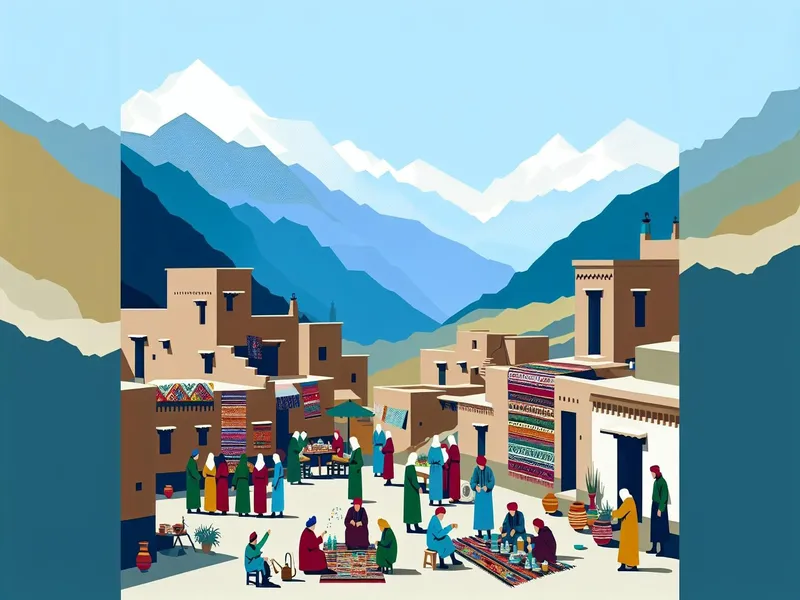
This region offers a treasure trove of experiences that transport you back in time, allowing you to walk in the footsteps of pharaohs, emperors, and sultans.
Ignoring the call of these historical wonders means missing out on an incredible opportunity to enrich your understanding of human history. Without exploring these sites, you’ll never fully appreciate the intricate world of cultures that have shaped our world today.
Having traveled extensively through North Africa myself, I’ve uncovered some hidden gems and well-known landmarks that are must-sees for any history enthusiast. My insights can help guide your journey, ensuring you make the most of your travels.
Whether you’re an avid historian or simply love discovering new places with fascinating stories, this guide is tailored for you. Let’s begin on this historical adventure together and uncover the secrets of North Africa’s past. For more travel inspiration and activities to complement your trip, check out this article.
Exploring the Rich History of North Africa
North Africa’s history isn’t just pages in a textbook. It’s alive, vibrant, and waiting for you to explore it. Imagine walking through ancient ruins where pharaohs once ruled or standing in a bustling medina that hasn’t changed much since medieval times.
Ancient Egyptian Wonders
When I first visited Egypt, the pyramids at Giza took my breath away. These colossal structures are not only architectural marvels but also windows into an era of divine kingship and monumental ambition. Seeing the Great Sphinx up close feels like stepping into another world entirely.
- Pyramids of Giza: Built over 4,500 years ago, these pyramids were tombs for pharaohs.
- Valley of the Kings: Located near Luxor, this valley contains over 60 tombs of pharaohs and nobles.
Carthaginian Treasures
Tunisia’s Carthage offers a fascinating jump into Phoenician civilization. As I wandered through its ancient streets, the remnants of this once-great city revealed stories of maritime prowess and relentless conflicts with Rome.
- Tophet of Salammbo: A sacred precinct containing urns with remains; it’s both eerie and captivating.
- Roman Baths: The Antonine Baths show how Romans lived luxuriously even far from home.
Moroccan Medinas
The medinas (old towns) in Morocco are labyrinthine wonders. Places like Fes and Marrakech are sensory overloads—in the best way possible. Walking through these narrow alleys feels like time traveling to an age when life was simpler but no less rich.
- Fes El Bali: One of the world’s largest urban pedestrian zones; it’s packed with historical sites.
- Jemaa el-Fnaa: Marrakech’s main square transforms every evening into a lively cultural spectacle.
Algerian Antiquities
Algeria often flies under travelers’ radars, yet its Roman ruins rival those in Italy itself! Timgad is a perfect example—a sprawling archaeological site that’s remarkably well-preserved considering its age.
- Timgad: Known as “Pompeii of Africa,” this Roman city has everything from theaters to baths.
- Djemila: Another UNESCO World Heritage Site featuring stunning mosaics and temples.
Libyan Ruins
Libya might not be on everyone’s travel list right now due to political instability, but historically speaking, it’s goldmine material! Leptis Magna stands out as one brilliantly preserved Roman city worth dreaming about visiting someday soon when conditions improve.
Exploring North Africa isn’t just about ticking off famous sites on your bucket list; it’s about immersing yourself in stories etched into stone walls or whispered by desert winds—stories that connect us all across millennia.
Must-Visit Historical Sites

Exploring North Africa’s historical sites is like opening a time capsule. You’ll find yourself stepping into stories that have shaped human civilization. Here are some must-visit spots you can’t miss.
The Pyramids of Giza, Egypt
When you think of Egypt, the Pyramids of Giza probably come to mind first. These ancient marvels aren’t just heaps of stone; they’re monumental tombs for pharaohs. Picture this: standing before the Great Pyramid, feeling dwarfed by its sheer size and wondering how on earth ancient Egyptians built it without modern machinery.
Take a camel ride around the site or visit the nearby Sphinx—it’s got the body of a lion and the face of a king! Fun fact: there are three main pyramids at Giza, but over 100 smaller ones scattered across Egypt.
Carthage, Tunisia
Carthage in Tunisia offers an intriguing peek into Phoenician and Roman history. Wander through ruins where powerful civilizations once thrived. I remember feeling awestruck by the grandeur of the Antonine Baths—imagine soaking in luxury with views of the Mediterranean Sea.
Don’t skip out on Salammbo’s Tophet either; it’s an eerie yet fascinating spot with burial urns dating back centuries. If you’re a history buff like me, you’ll love piecing together Carthage’s story from these remnants.
Roman Ruins of Leptis Magna, Libya
Leptis Magna in Libya is an archaeological gem that rivals even Rome itself! Walking through its well-preserved streets feels like traveling back to ancient times. You’ll see majestic arches and grand forums that speak volumes about Roman architectural prowess.
One memorable moment for me was standing under the Severan Arch—you can almost hear echoes from bustling marketplaces long gone. Though travel to Libya has its challenges now, keep this site on your bucket list for when it becomes more accessible.
Cultural Heritage and Local Traditions

North Africa is a treasure trove of cultural heritage and local traditions. You can feel the pulse of ancient civilizations in every city. Let’s jump into some of the unique aspects that make this region so fascinating.
Berber Culture
The Berbers, also known as Amazigh, are indigenous people who have lived in North Africa for thousands of years. Their culture is vibrant, with colorful textiles, intricate jewelry, and mesmerizing music.
I remember visiting a small Berber village in Morocco’s Atlas Mountains. The warmth and hospitality were unmatched—locals invited me to share mint tea and couscous. They showed me how they hand-weave rugs using techniques passed down through generations. If you’re lucky enough to experience a traditional Berber wedding, you’ll be treated to music played on instruments like the rebab (a string instrument) and dances that tell stories of love and bravery.
- Language: Tamazight
- Cuisine: Tagine, couscous
- Music Instruments: Rebab, bendir (frame drum)
Islamic Influence
Islam has profoundly shaped the cultural world of North Africa since its arrival in the 7th century. This is evident in the stunning mosques, madrasas (schools), and bustling souks (markets).
When I walked through Fes’ medina in Morocco, I felt like I’d traveled back in time. The call to prayer echoed through narrow alleyways lined with stalls selling spices, lanterns, and leather goods. In Tunisia’s capital Tunis, I marveled at the intricate tile work inside the Zitouna Mosque, one of Islam’s oldest universities.
- Architecture: Horseshoe arches
- Calligraphy: Arabic script decorates walls
- Markets: Souks brimming with handmade crafts
Exploring these cultural elements lets you connect deeply with North African history while enjoying unforgettable experiences along the way.
Travel Tips and Recommendations
Exploring North Africa’s historical sites is like stepping into a time machine. Let me share some handy tips to make your journey smooth and unforgettable.
Best Time to Visit
Timing is everything when it comes to travel. In North Africa, the best months to visit are generally from October to April. During this period, you dodge the extreme summer heat.
- Egypt: I found November perfect for visiting Giza; temperatures were comfortable enough for long days of exploring pyramids.
- Morocco: Spring (March-May) is ideal. The weather’s mild, and the landscapes bloom beautifully.
- Tunisia & Algeria: Winter months (December-February) offer cooler temps, perfect for wandering around ancient ruins without breaking a sweat.
Remember, Ramadan might impact your plans as many businesses close or operate on reduced hours during this holy month.
Safety and Security
Safety first! While North Africa is generally safe for tourists, it’s good to stay informed about local conditions.
- Stay Updated: Check recent travel advisories from reliable sources like the U.S. State Department before booking your trip.
- Local Advice: I always chat with locals or hotel staff about which areas are safe to explore alone—locals know best!
- Personal Belongings: Keep an eye on your stuff in crowded markets (souks). A small cross-body bag with secure zippers works wonders.
Once in Tunisia, I got lost in Tunis’ medina but felt at ease asking shopkeepers for directions—they’re super friendly and helpful!
Sample Itinerary for History Travel
Planning a history-focused trip to North Africa? I’ve got you covered with two tailored itineraries that’ll help you explore the region’s rich past. Let’s immerse!
7-Day Itinerary
Day 1-2: Cairo, Egypt
Start in Cairo. Visit the iconic Pyramids of Giza and the Sphinx. Don’t miss the Egyptian Museum; it’s like stepping into a time machine.
Day 3-4: Tunis, Tunisia
Fly to Tunis. Explore Carthage’s ancient ruins and marvel at the Bardo Museum’s Roman mosaics.
Day 5-6: Marrakech, Morocco
Head to Marrakech. Get lost in the medina and visit historical sites like Bahia Palace.
Day 7: Tripoli, Libya
If travel permits, end your journey at Leptis Magna near Tripoli. The Roman architecture here is mind-blowing.
14-Day Itinerary
Day 1-3: Cairo and Alexandria, Egypt
Spend an extra day exploring Alexandria’s Library and Catacombs after Cairo’s highlights.
Day 4-6: Tunis and Dougga, Tunisia
Plus to Carthage, take a day trip to Dougga for more Roman ruins.
Day 7-9: Algiers and Timgad, Algeria
Fly to Algiers. Visit Timgad’s well-preserved Roman cityscape; it feels like walking through history.
Day 10-12: Marrakech and Fes, Morocco
Incorporate Fes into your Moroccan leg. Its medieval medina offers countless historical treasures.
Day 13-14: Tripoli and Leptis Magna, Libya
Finish by diving deeper into Libyan history with another day at Leptis Magna or visiting nearby Sabratha ruins if accessible.
Final Thoughts
Exploring North Africa’s historical sites offers an unparalleled journey through time and culture. It’s not just about visiting landmarks; it’s about experiencing the stories and traditions that have shaped human history. From the majestic pyramids of Giza to the vibrant medinas of Morocco, each destination reveals a unique chapter in our shared past.
Whether you’re marveling at Roman ruins in Algeria or immersing yourself in Berber culture, every moment is a step closer to understanding this rich region. With practical tips and well-crafted itineraries, you can make the most of your historical adventure. So pack your bags and get ready to uncover the secrets of North Africa’s timeless heritage.